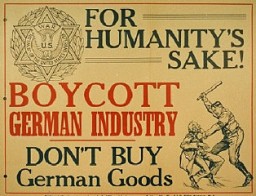
Photo
Browse an alphabetical list of photographs. These historical images portray people, places, and events before, during, and after World War II and the Holocaust.
<< Previous | Displaying results 101-150 of 228 for "Photo" | Next >>
-
Portrait of Helen Keller
PhotoPortrait of Helen Keller, seated, reading Braille. September 1907. In 1933, Nazi students at more than 30 German universities pillaged libraries in search of books they considered to be "un-German." Among the literary and political writings they threw into the flames during the book burning were the works of Helen Keller.
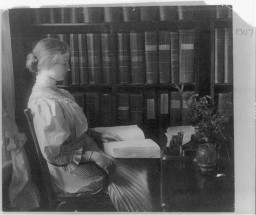
-
Portrait of Herschel Grynszpan
PhotoPortrait of Herschel Grynszpan taken after his arrest by French authorities for the assassination of German diplomat Ernst vom Rath. Grynszpan (1921-1943?). Born in Hannover, Germany, was the son of Polish Jews who had immigrated to Germany. In 1936 Grynszpan fled to Paris. On November 7, 1938, after having learned of the expulsion of his parents from Germany to Zbaszyn the Polish frontier, Grynszpan assassinated Ernst vom Rath, the third secretary of the German embassy in Paris. The diplomat's…
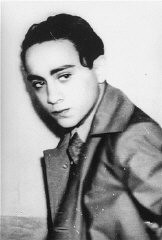
-
Portrait of Ita Guttman with her twin children Rene and Renate
Photo1942 portrait of Ita Guttman with her twin children Rene and Renate. When the twins were very young, the family moved to Prague. In the fall of 1941 the Germans arrested Ita's husband, Herbert. Subsequently, the twins and their mother were deported to Theresienstadt, and from there, to Auschwitz.

-
Portrait of James Ingo Freed
PhotoPortrait of James Ingo Freed, architect of the United States Holocaust Memorial Museum. New York, April 1992.

-
Portrait of Jan Karski
PhotoJan Karski, underground courier for the Polish government-in-exile, informed the West in the fall of 1942 about Nazi atrocities against Jews taking place in Poland. Washington, DC, United States, 1943.
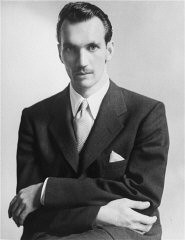
-
Portrait of Janusz Korczak
PhotoPortrait of Janusz Korczak, a Polish Jewish doctor and author who ran a Jewish orphanage in Warsaw, circa 1930.
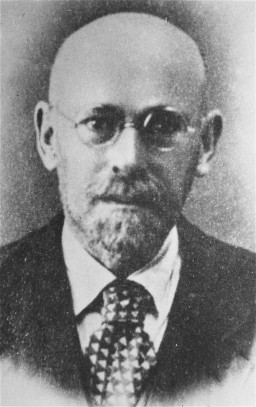
-
Portrait of Jehovah's Witness Aart Bouter
PhotoAart Bouter, a Jehovah's Witness, was arrested by the Dutch police and deported to Sachsenhausen concentration camp. The Netherlands, 1946–47.
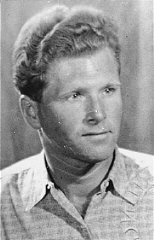
-
Portrait of Jehovah's Witness Hildegard Kusserow
PhotoHildegard Kusserow, a Jehovah's Witness, was imprisoned for four years in several concentration camps including Ravensbrück. Germany, date uncertain.
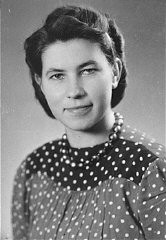
-
Portrait of Josef Kaplan
PhotoPortrait of Josef Kaplan. Kaplan was a youth movement leader. He was also a leader of the Warsaw ghetto underground and Jewish Fighting Organization (ZOB). He was caught preparing forged documents and was killed. Poland, before September 1942.

-
Portrait of Lazar Ischach
PhotoPortrait of Lazar Ischach, son of Yosef Ischach. He was a grocer and lived at Drinska 77 in Bitola. This photograph was one of the individual and family portraits of members of the Jewish community of Bitola, Macedonia, used by Bulgarian occupation authorities to register the Jewish population prior to its deportation in March 1943.
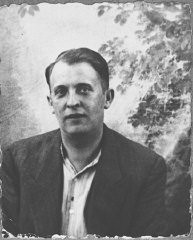
-
Portrait of Leon Pardo
PhotoPortrait of Leon Pardo. He lived on Sremska in Bitola. This photograph was one of the individual and family portraits of members of the Jewish community of Bitola, Macedonia, used by Bulgarian occupation authorities to register the Jewish population prior to its deportation in March 1943.

-
Portrait of Margot (Miriam) and Gerhard (Gad) Beck
PhotoGerhard and Margot's mother came from a Protestant family. She met her future husband when she went to work in the telephone exchange at his company. She converted to Judaism in 1920. The couple married in 1920, and in 1923 had their twins Gerhard and Margot. Both Gerhard and Margot would become active in Jewish youth movements, and took on Hebrew names (Gad and Miriam). On February 17, 1943, Gad was ordered to report to the temporary internment camp established at a former Jewish community building on…

-
Portrait of Martin Bormann
PhotoPortrait of Nazi Party official Martin Bormann. Bormann died in an effort to flee Berlin in the last days of World War II, but was long thought to be at large. He was tried in absentia at the International Military Tribunal in Nuremberg, where he was sentenced to death.

-
Portrait of members of a Hungarian Jewish family
PhotoPortrait of members of a Hungarian Jewish family. They were deported to and killed in Auschwitz soon after this photo was taken. Kapuvar, Hungary, June 8, 1944.
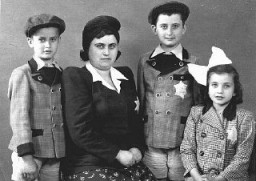
-
Portrait of members of the Freemasons Lodge of Chernovtsy, Bukovina
PhotoGroup portrait of members of the Freemasons Lodge of Chernovtsy, Bukovina, approximately 75 percent of whom were Jewish. The members were mainly intellectuals and leaders in business and local government. Among those pictured are Dr. Max Ennis (top row, third from the left); pharmacist, Dr. Abraham Guttman (top row, far right); an official in the revenue service, Dr. Max Gottfried (second row from the top, sixth from the left); and the judge, Dr. Jacob Rubel (third row from the top, far left). Chernovtsy,…
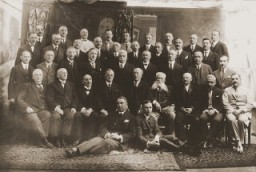
-
Portrait of Mordechai Mishulam
PhotoPortrait of Mordechai Mishulam. He was a dealer of second-hand items. He lived at Zmayeva 23 in Bitola. This photograph was one of the individual and family portraits of members of the Jewish community of Bitola, Macedonia, used by Bulgarian occupation authorities to register the Jewish population prior to its deportation in March 1943.
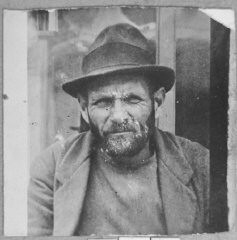
-
Portrait of Norman Salsitz's family
PhotoIn this 1934 portrait of Norman Salsitz's family, Norman is seated in the front row (at left). In the top row, center, an image of one of Norman's brothers has been pasted into the photograph. This is seen by comparing the size of the brother's face with the others pictured. Pasting in images of family members who could not be present during family portraits was common practice and in some cases the resulting composite images are the only remaining visual records of family groups.

-
Portrait of Palomba Kalderon
PhotoPortrait of Palomba Kalderon, daughter of Mushon Kalderon. She was a student and lived at Dalmatinska 65 in Bitola. This photograph was one of the individual and family portraits of members of the Jewish community of Bitola, Macedonia, used by Bulgarian occupation authorities to register the Jewish population prior to its deportation in March 1943.
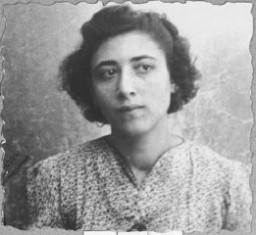
-
Portrait of Rabbi S. Djain
PhotoPortrait of Rabbi S. Djain, taken in Bitola. This photograph was one of the individual and family portraits of members of the Jewish community of Bitola, Macedonia, used by Bulgarian occupation authorities to register the Jewish population prior to its deportation in March 1943.
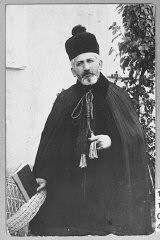
-
Portrait of Rabbi Shimon Huberband
PhotoPortrait of Rabbi Shimon Hoberband, who was involved in the activities of Emanuel Ringelblum's Oneg Shabbat archives in the Warsaw ghetto.
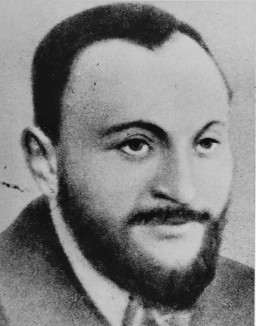
-
Portrait of Reinhard Heydrich
PhotoReinhard Heydrich, chief of the SD (Security Service) and Nazi governor of Bohemia and Moravia. Place uncertain, 1942.
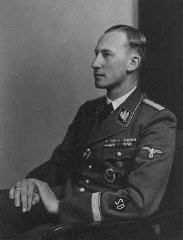
-
Portrait of Sara Ischach
PhotoPortrait of Sara Ischach, wife of Lazar Ischach. She lived at Drinksa 77 in Bitola. This photograph was one of the individual and family portraits of members of the Jewish community of Bitola, Macedonia, used by Bulgarian occupation authorities to register the Jewish population prior to its deportation in March 1943.
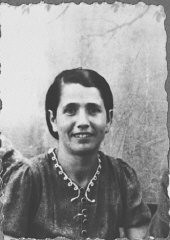
-
Portrait of Sara Israel
PhotoPortrait of Sara Israel, wife of Isak Israel. She lived at Krstitsa 10 in Bitola. This photograph was one of the individual and family portraits of members of the Jewish community of Bitola, Macedonia, used by Bulgarian occupation authorities to register the Jewish population prior to its deportation in March 1943.
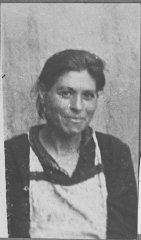
-
Portrait of Sigmund Freud
PhotoPortrait of Sigmund Freud. Freud's writings were burned during the 1933 book burnings.

-
Portrait of Solomon Kalderon
PhotoPortrait of Solomon Kalderon, son of Bohor Kalderon. He was a tailor and lived at Karagoryeva 67 in Bitola. This photograph was one of the individual and family portraits of members of the Jewish community of Bitola, Macedonia, used by Bulgarian occupation authorities to register the Jewish population prior to its deportation in March 1943.
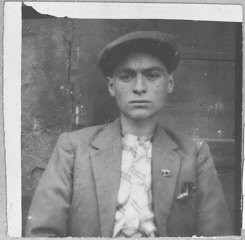
-

-
Portrait of the family of Bohor Kalderon
PhotoPortrait of the family of Bohor Kalderon. This photograph was one of the individual and family portraits of members of the Jewish community of Bitola, Macedonia, used by Bulgarian occupation authorities to register the Jewish population prior to its deportation in March 1943.

-
Portrait of the Katz Family
PhotoGroup portrait of members of the Katz family of Munkacs. Pictured in the top row from left to right are: Chicha, Isabella, Philip, Jolon (Cipi), and Regina. In the bottom row are Helen (left) and Tereza. Munkacs, 1942–1943.
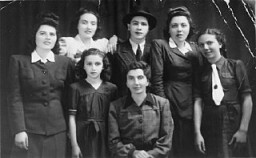
-
Portrait of the Rosenblat family in interwar Poland
PhotoPortrait of the Rosenblat family in interwar Poland. Photographed are: (back row from left to right) Elya, Jozef (father), and Itzik Rosenblat. Sitting from left to right are: Herschel, Deena (wife of Elya), Hannah (mother), and Taube Rosenblat (wife of Itzik). In 1941, a mobile killing unit killed Herschel in Slonim, Poland. Of the others, only Itzik and Deena survived deportation from the ghetto in Radom, Poland.
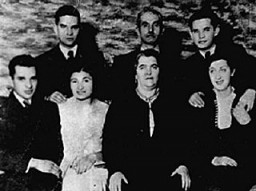
-
Portrait of the Weidenfeld family wearing Jewish badges in the Czernowitz ghetto
PhotoPortrait of the Weidenfeld family wearing Jewish badges in the Czernowitz (Cernauti) ghetto shortly before their deportation to Transnistria. Pictured from left to right are Yetty, Meshulem-Ber, Sallie, and Simche Weidenfeld. Cernauti, Romania, October 1941.
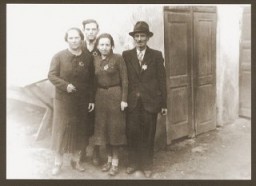
-
Portrait of three-year-old Estera Horn
PhotoPortrait of three-year-old Estera Horn wrapped in a fur coat. Chelm, Poland, ca. 1940. Estera was born in January 1937. Her father was killed soon after the Germans invaded Poland. Estera and her mother, Perla Horn, were forced into the ghetto in Chelm. At the end of 1942, during the liquidation of the ghetto, Perla and Estera escaped from the ghetto. They hid in nearby villages. In late 1943, Perla asked a family in Plawnice to take care of Estera. Perla tried to hide with a group of Jews in the nearby…
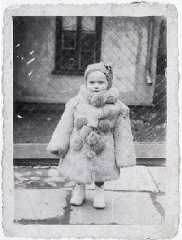
-
Portrait of Tosia Altman
PhotoPortrait of Tosia Altman (1918-1943), Jewish youth leader and member of the Jewish underground in the Warsaw ghetto.

-
Portrait of Tsewie Herschel taken while he was living in hiding
PhotoPortrait of Tsewie Herschel seated in a chair, taken while he was living in hiding. Oosterbeek, the Netherlands, 1943–1944. Tsewie never knew his parents. Born in December 1942, he was hidden with the de Jong family in April 1943. That July, his parents were deported from the Netherlands to the Sobibór killing center. The de Jongs renamed Tsewie "Henkie," raised him as a Christian, and treated him as their son. Tsewie learned about his origins from his paternal grandmother, who reclaimed him…

-
Portrait of two Romani (Gypsy) women
PhotoPortrait of two Romani (Gypsy) women. Both were deported to Auschwitz in 1941. Photograph taken in Czechoslovakia, 1937.
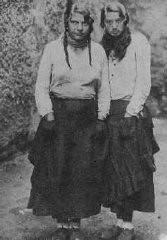
-
Portrait of two schoolchildren, Solomon Faradji and Sami Levi
PhotoPortrait of two schoolchildren: Solomon Faradji, son of Avram Faradji, and Sami Levi, son of Rafael Levi. Solomon lived at Karagoryeva 113, and Sami lived at Karagoryeva 105, in Bitola. This photograph was one of the individual and family portraits of members of the Jewish community of Bitola, Macedonia, used by Bulgarian occupation authorities to register the Jewish population prior to its deportation in March 1943.
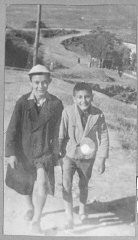
-
Portrait of Victoria and Isak Assael
PhotoPortrait of Victoria and Isak Assael, the daughter and son of Shabetai Assael. They were students and lived at Sremska 9 in Bitola. This photograph was one of the individual and family portraits of members of the Jewish community of Bitola, Macedonia, used by Bulgarian occupation authorities to register the Jewish population prior to its deportation in March 1943.
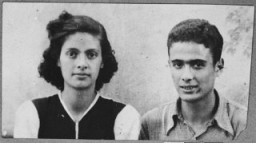
-
Portrait of Vida Kalderon
PhotoPortrait of Vida Kalderon, wife of Yakov Kalderon. She lived at Orisarska 2 in Bitola. This photograph was one of the individual and family portraits of members of the Jewish community of Bitola, Macedonia, used by Bulgarian occupation authorities to register the Jewish population prior to its deportation in March 1943.

-
Portrait of Walter Marx and his family
PhotoWalter Marx (standing at left) with father Ludwig, mother Johanna, and cousin Werner. In 1944, Walter joined partisans in Italy. He was the only one in the photograph to survive the Holocaust.
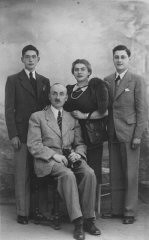
-
Portrait of writer Sigrid Undset
PhotoPortrait of writer Sigrid Undset, who won the Nobel Prize for Literature in 1928. Often with feminist themes, her novels were banned and burned in part because of her public criticism of the Nazi regime. Photo taken by Anders Beer Wilse on July 1, 1923.
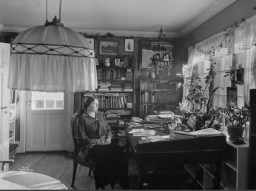
-
Portrait of Yakov Testa with his wife and three children
PhotoPortrait of Yakov Testa with wife and three children in Bitola. This photograph was one of the individual and family portraits of members of the Jewish community of Bitola, Macedonia, used by Bulgarian occupation authorities to register the Jewish population prior to its deportation in March 1943.
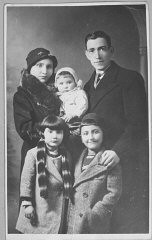
-
Portrait of Yosef Eschkenasi and his wife, Sara
PhotoPortrait of Yosef Eschkenasi and his wife, Sara. Yosef was a laborer. They lived at Zmayeva 10 in Bitola. This photograph was one of the individual and family portraits of members of the Jewish community of Bitola, Macedonia, used by Bulgarian occupation authorities to register the Jewish population prior to its deportation in March 1943.

-
Portrait of Żegota co-founder Władysław Bartoszewski
PhotoPortrait of Władysław Bartoszewski, Poland, unknown date. Władysław Bartoszewski (1922–2015) was a co-founder and member of the Council for Aid to Jews, codenamed “Żegota.” Żegota was a clandestine rescue organization of Poles and Jews in German-occupied Poland. Supported by the Polish government-in-exile, Żegota coordinated efforts to save Jews from Nazi persecution and murder. It operated from 1942 to 1945. After World War II broke out in September 1939, Władysław worked as a janitor…
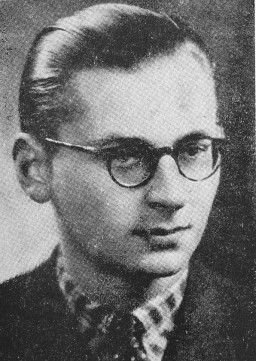
-
Portrait of Żegota member Andrzej Klimowicz
PhotoWartime portrait of Andrzej Klimowicz, Poland. Andrzej Klimowicz (1918–1996) aided and rescued Jews in Warsaw throughout the duration of the German occupation of Poland. He eventually became a member of the Council for Aid to Jews (codenamed “Żegota”), a clandestine organization that coordinated efforts to save Jews from Nazi persecution and murder. Under the auspices of Żegota, Andrzej played a role in providing Jews in Warsaw with forged identity papers and hiding places outside the walls of the…
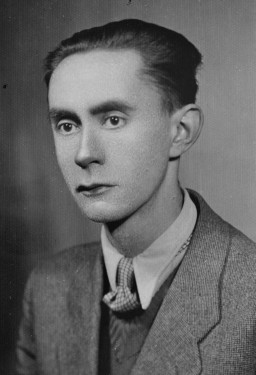
-
Portrait of Żegota member Irena Sendler
PhotoPortrait of Irena Sendler in Warsaw, Poland, circa 1939. Irena Sendler (1910–2008) was a member of the Council for Aid to Jews, codenamed “Żegota.” Żegota was a clandestine rescue organization of Poles and Jews in German-occupied Poland. Supported by the Polish government-in-exile, Żegota coordinated efforts to save Jews from Nazi persecution and murder. It operated from 1942 to 1945. Irena Sendler (Sendlerowa) was working as a social worker in Warsaw when World War II broke out in 1939. After…
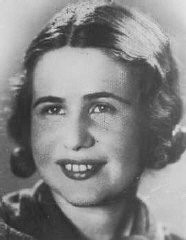
-
Portraits of Martha and Waitstill Sharp
PhotoPortraits of Martha and Waitstill Sharp from an unknown newspaper. Published before they left for Europe on a relief mission with the Unitarian Service Committee.
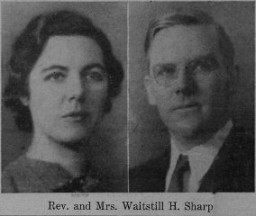
-
Portraits of Zionist leaders hang in a classroom
PhotoLyrics to the Jewish national anthem and portraits of Zionist leaders hang in a classroom in a displaced persons camp. Feldafing, Germany, after April 1945.

-
Postcard of Evian-les-Bains
PhotoPeriod postcard of Evian-les-Bains, the site of the 1938 International Conference on Refugees.
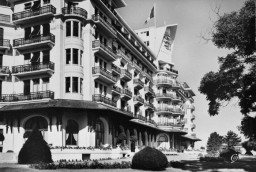
-
Postcard of the SS St. Louis
PhotoA postcard of the SS St. Louis. May 1939. The plight of German-Jewish refugees, persecuted at home and unwanted abroad, is illustrated by the May 13, 1939, voyage of the SS St. Louis.

-
Poster advertising the antisemitic propaganda film "Der ewige Jude"
PhotoA poster advertising the antisemitic propaganda film "Der ewige Jude" (The Eternal Jew) hangs on the side of a Dutch building. Amsterdam, The Netherlands, 1942.
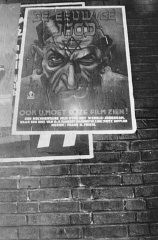
-
Poster calling for a boycott of German goods
PhotoPoster calling for a boycott of German goods. Issued by the Jewish War Veterans of the United States. New York, United States, between 1937 and 1939.
